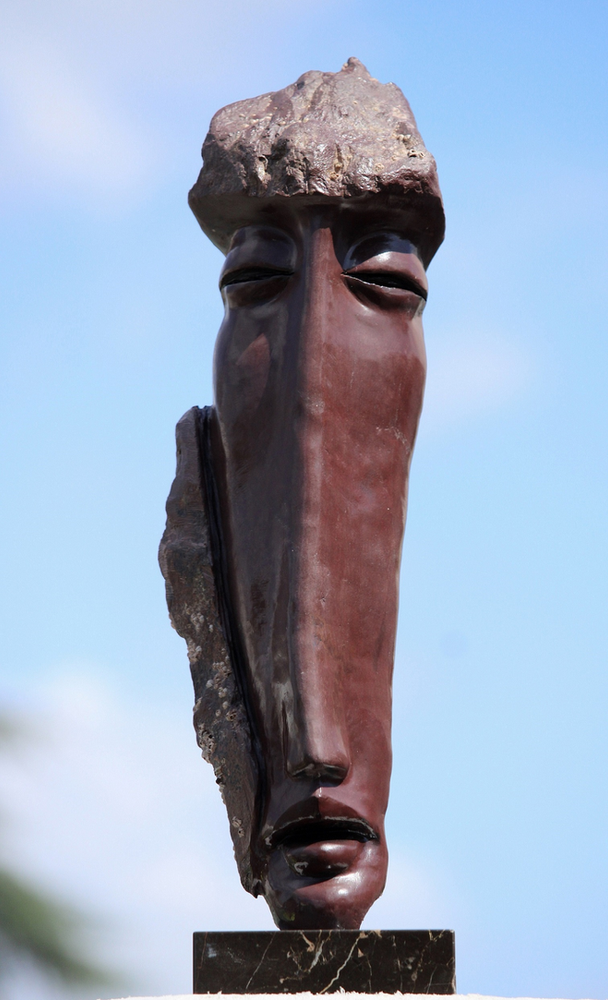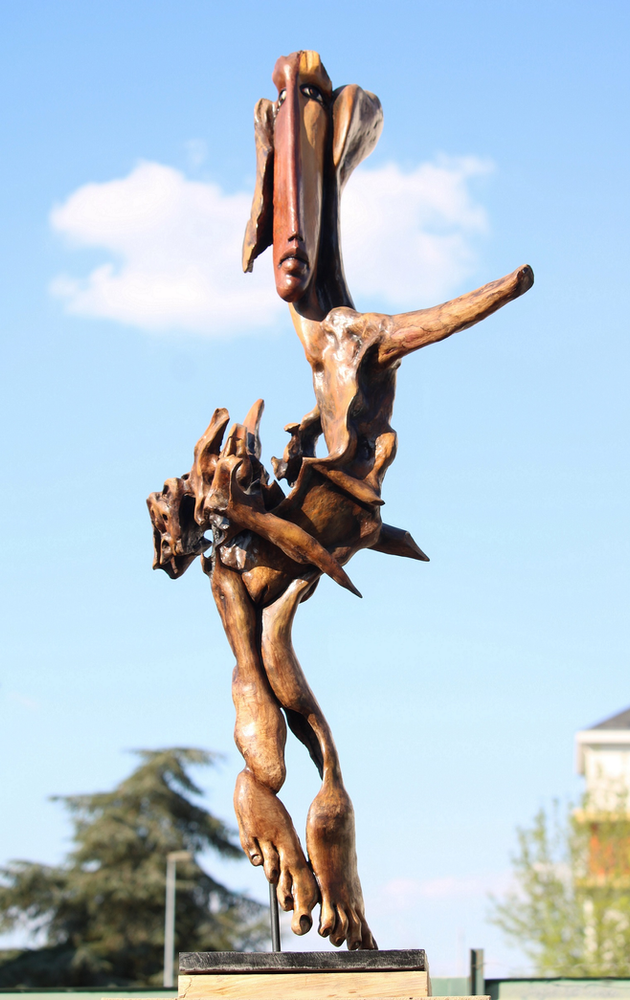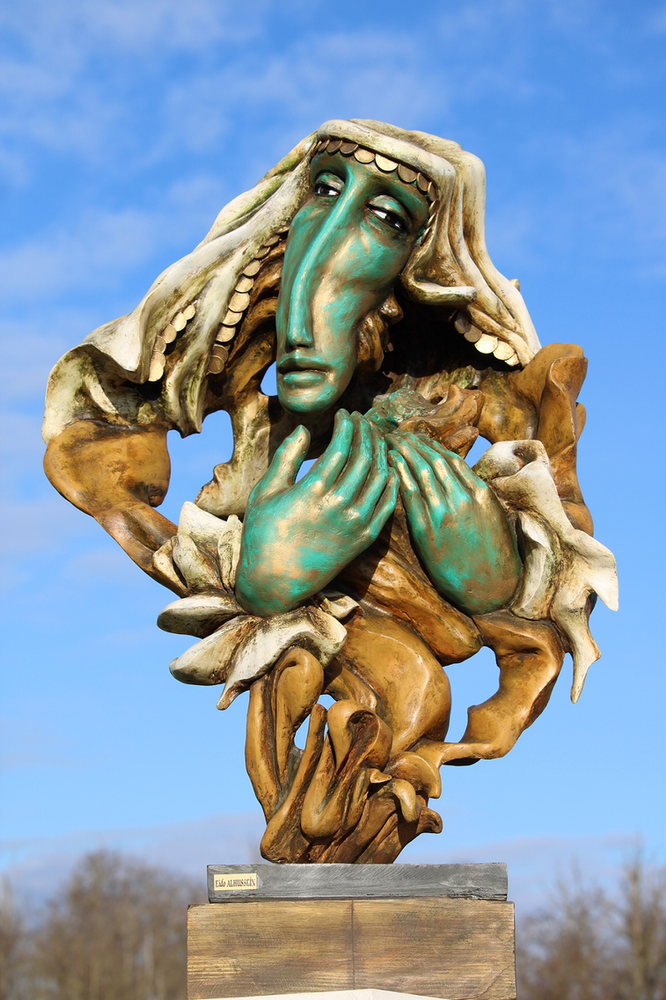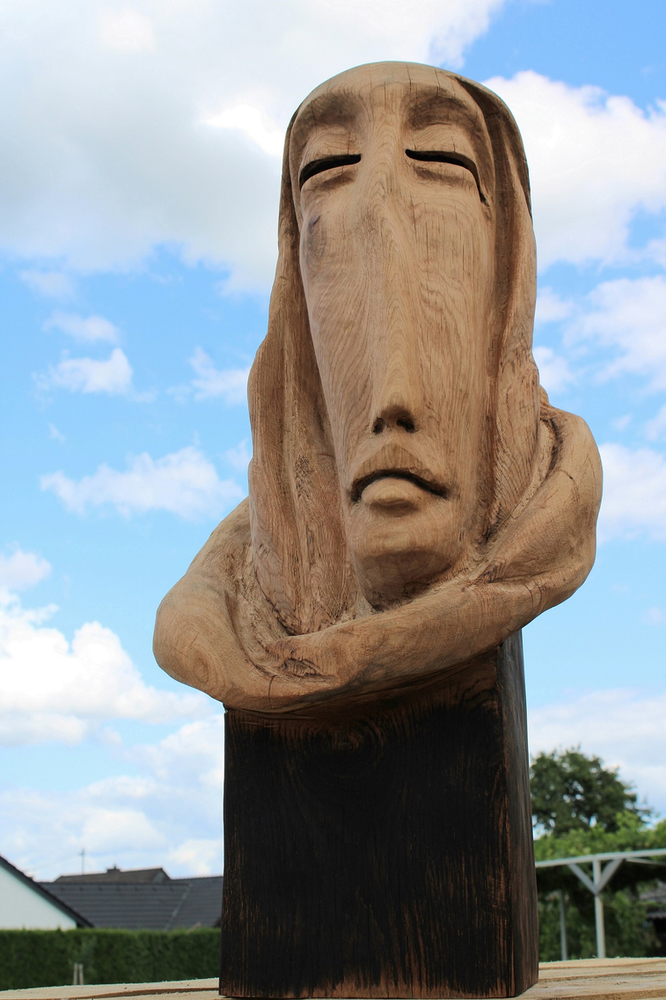
Eido Alhussein
Le cicatrici dell’essere umano si nascondono in un’interiorità che deve essere protetta dall’esterno, soprattutto nella società contemporanea dove l’altro è costantemente visto come una minaccia, come un antagonista da cui doversi difendere e tutelare per evitare che nello scontro tra diverse personalità uno dei due prevarichi e l’altro soccomba. Nelle incredibili opere di Eido Alhussein invece, le ferite sono protagoniste dei volti e dei corpi che sembrano piegarsi, inermi, al susseguirsi degli accadimenti, come se in qualche modo sapessero di dover sussistere malgrado tutto, a dispetto di tutto ciò che potrebbe anche distruggere un’interiorità troppo fragile. Di origine siriana, lo scultore ha visto con i propri occhi la distruzione e il dolore provocati da una guerra inutile, le cui vittime sono state, e continuano a essere, le persone, tutte quelle che fino a un attimo prima conducevano un’esistenza tranquilla, a volte noiosa, altre esaltante, e che dal conflitto sono state sorprese all’improvviso e si sono viste togliere tutto, affetti, quotidianità, casa, famiglia. Eido Alhussein non riesce a staccarsi dal senso di disorientamento, di solitudine, di impotenza, che ha letto negli occhi della sua gente, malgrado lui sia riuscito a fuggire da quella devastante realtà, e decide di narrarne le sensazioni attraverso opere scultoree di grandi dimensioni e di forte impatto emotivo. Sceglie uno stile cubista che si lega in maniera incisiva al Primitivismo, mescolando le linee rette e rigide tipiche di entrambi a una morbidezza che sta a rappresentare la fragilità dell’animo umano, quella distorsione emozionale alla quale non è possibile lasciarsi andare perché ciò significherebbe soggiacere; la necessità che emerge dalle opere di Alhussein è quella di resistere attingendo a una resilienza inattesa, alla capacità di restare in piedi anche quando tutto intorno e al di fuori della forza interiore è irrimediabilmente cambiato, modificato per sempre.

Un visage I
Le enormi sculture trovano la collocazione perfetta en plein air, perché solo quando si trovano calate nella natura e sottoposte all’alternarsi degli eventi climatici, esprimono al meglio quel senso di opposizione al vento, al sole, alle intemperie che per l’artista corrisponde all’atteggiamento che il suo popolo ha avuto nei confronti di un evento incontrastabile, inevitabile, se considerato dal punto di vista delle possibilità del singolo, e certamente travolgente. I materiali scelti per le sue grandi sculture sono il marmo, il granito, il quarzo, il ferro, duri e difficili da forgiare nella modalità distorta e visivamente liquefatta che costituisce la caratteristica principale di Eido Alhussein, e proprio per questo incisivi sul messaggio che l’artista desidera lasciare al fruitore delle sue opere.

Venus contemporaine
L’invito è quello di spingersi oltre l’apparenza, di andare più a fondo e raggiungere la sostanza perché è quella a contraddistinguere l’unicità della persona, a restare quando, per vari motivi, l’esteriorità sfiorisce, si modifica, si estingue; è proprio in questo che Alhussein riesce a conquistare lo sguardo, in quel suo non aver timore di svelare debolezze, dolore, ferite, imperfezioni, in un’epoca e in una società occidentale in cui invece l’aspetto fisico, la corsa alla bellezza e l’attenzione alle vacuità dell’esistenza sembrano essere imperativi irrinunciabili. Così come la plasticità duttile, il contorcersi degli sguardi, dei volti e dei corpi protagonisti delle sue sculture, conducono l’osservatore a riflettere sulla continua evoluzione e modificazione a cui ciascun individuo viene sottoposto a seguito degli accadimenti della vita. Approfondiamo questi concetti direttamente con l’artista.
Eido, lei ha visto in prima persona ciò che fa la guerra alle persone e alle loro vite; può raccontarci come è riuscito a scappare da una situazione ormai intollerabile e quanto la sua esperienza di vita abbia segnato il suo cammino artistico?
Sì, ho visto la guerra, e quale guerra! Le persone, gli animali, persino le piante, tutti sono accusati, condannati e minacciati di annientamento e sterminio finché non dimostrano fedeltà all’altro e negazione di se stessi. Non potrei riassumere ed esprimere i miei sentimenti, la forza del rifiuto, la confusione e le infinite domande del danno causato da questa guerra in nessun modo se non secondo quanto appare e si dichiara nei miei volti e nelle mie sculture. Ho lasciato la Siria alla fine del 2012 per Beirut, la mia prima tappa, dove sono rimasto per più di un anno, poi ho viaggiato a verso Istanbul, e lì mi sono fermato per più di tre anni, e infine la Francia, quello che è diventato il mio paese d’adozione dalla fine del 2016. In ogni spostamento e tappa della mia vita personale, c’è stato un processo completo di costruzione, distruzione, instabilità e confusione. Queste sofferenze e sanguinamenti personali erano sempre accompagnati dall’incoscienza, da un sogno di stabilità, sicurezza e da un profondo recupero spirituale con maggiore passione e amore per la vita.

Une mère kurde
Ha scelto uno stile complesso, un Cubismo personalizzato in cui le forme non sono spigolose bensì morbide, duttili, fluide. Quali sono le maggiori difficoltà che incontra nell’esecuzione delle sue sculture?
La scultura è un lavoro difficile e complesso che richiede sforzo e una buona conoscenza degli strumenti e dei materiali utilizzati. Questo richiede anche una speciale abilità nel condurre e controllare il materiale nelle tue mani per creare da esso un’opera d’arte come vuoi tu e non il contrario. I materiali con cui lavoro sono in primo luogo materiali molto difficili come il granito, basalto e la selce, così come il vetro. Ho attraversato molte ostacoli e problemi sul lavoro, ma con perseveranza, esperienza, ricerca e determinazione, li ho superati. Una delle grandi difficoltà che affronto quando scolpisco è la mancanza del tempo necessario e delle capacità richieste per attuare ciò che penso e ciò che mi passa per la testa perché sono impaziente di realizzarlo.

Un visage II
Quali sono stati i maestri del passato che l’hanno ispirata di più? Il tema della liquefazione è stato anticipato nel Novecento da Salvador Dalì, si sente in qualche modo legato o influenzato dal suo Surrealismo?
Non considero la mia opera d’arte e i miei volti scultorei nella loro fluidità e morbidezza come un’influenza del Surrealismo di Salvador Dali. La mia opera d’arte può incontrare le sue opere in questo o in un altro aspetto, ma è molto lontana da altri aspetti, anche se sono molto impressionato dalle sue opere d’arte immortali tanto quanto lo sono dalle opere di Rodin, Michaelangelo, Giacometti, Henry Moore e Modigliani. Le mie opere scultoree riflettono, mostrano ed esprimono quell’eterno conflitto che ha luogo nell’uomo. Il conflitto ruota intorno al suo legame con la terra, la storia, la patria e i ricordi da un lato, così come il suo sogno e la sua ricerca della libertà di volare e librarsi nei cieli, conducendo a Dio, al paradiso e all’immortalità dall’altro, ma anche gli effetti del tempo e degli eventi personali che accompagnano questa lotta. Oltre ovviamente all’ingiustizia, lo sterminio e la negazione dei diritti e dell’esistenza, nel passato e nel presente, che il popolo curdo al quale appartengo, ha subìto. Tutte queste sensazioni insieme sono alla base del mio lavoro e cerco di tradurle in manifestazioni e caratteristiche, sia razionalmente che inconsciamente, in modo che appaiano chiare e profonde sui volti delle mie opere scultoree. Dall’altro lato è anche un’estensione dell’antica civiltà mesopotamica, della civiltà dell’Oriente nel suo profondo aspetto spirituale e teologico, in una cornice modernista che armonizza e tiene conto di ciò che la scultura ha raggiunto al momento attuale.
I materiali duri come il granito, il marmo e il ferro sono i più difficili da modellare, in particolar modo quando si deve infondere un senso di morbidezza, di dinamicità che sono sempre presenti in ciascuna delle sue sculture, come riesce a piegare la materia alla sua volontà e al suo intento espressivo? E quanto l’intensità del risultato finale sia al contrario dovuto proprio a quella particolare durezza della materia?
Il mio lavoro nel campo dell’antiquariato e del restauro di oggetti antichi mi ha dato molta esperienza e abilità nel trattare diversi strumenti e materiali, così come la testimonianza e il contatto con molteplici e diverse culture attraverso differenti tempi, che mi ha portato a ottenere una buona cultura nell’arte visiva. Il materiale che mi attrae di più nella scultura è la pietra con i suoi colori nascosti, le sue venature e la sua bellezza accompagnata a solidità e durezza. È il mio amore senza fine. Tra le pietre ho scelto le più dure come il granito, il basalto e la selce. Tuttavia, non mi piacciono gli angoli e le rifrazioni e tutto ciò che indica crudeltà e violenza e disturba i sentimenti umani. Piuttosto la tratto come una massa d’anima che conversa con me e scambia molte soluzioni e chiavi artistiche; do e condivido con lei la mia anima e tutti i miei sentimenti e lascio che scorra e si pieghi con amore e tenerezza, come musica e tempo, come acqua, aria e fuoco, affinché la sua storia si dispieghi come le piace di più. Certamente l’armonia e l’attrattiva della forma con il potere di suggestioni e sentimenti espressivi che l’opera mostra con gli effetti estetici dei colori e delle venature e il valore della materia prima che la compone, danno vita a un’opera scultorea perfetta che attrae lo spettatore e impone la sua presenza lasciando un forte impatto sul fruitore.

Le dernier diner
Lei ha avuto molti riconoscimenti e premi, nel corso della sua lunga carriera, ed è stato ospite speciale in molte mostre internazionali, quali sono i suoi prossimi progetti?
Ho molti progetti e idee che sto cercando di realizzare in futuro, spero che il tempo e le capacità mi sostengano per realizzarli. Per quanto riguarda le mostre e le partecipazioni, ho in programma una mostra a Parigi 2022 e una in Germania.
EIDO ALHUSSEIN-CONTATTI
Email: alhussein.eido@gmail.com
Facebook: https://www.facebook.com/ido.alhussain.9
Instagram: https://www.instagram.com/eidoalhussein/
Marta Lock’s interviews:
Eido Alhussein, the liquefied Cubism that narrates human wounds
The scars of the human being are hidden in an interiority that must be protected from the outside world, especially in today’s society where the other person is constantly seen as a threat, as an antagonist to be defended and protected from, so that in the clash between different personalities one of them prevails and the other succumbs. In the incredible works of Eido Alhussein, on the other hand, wounds are the protagonists of faces and bodies that seem to bend, helpless, to the succession of events, as if somehow they knew they had to survive in spite of everything, in spite of everything that could destroy an interiority that is too fragile. Of Syrian origin, the sculptor has seen with his own eyes the destruction and pain caused by an unnecessary war, whose victims have been, and continue to be, the people, all those who until a moment before were leading a peaceful, sometimes boring, sometimes exciting existence, and who have been suddenly surprised by the conflict and have had everything taken away from them, affections, everyday life, home and family. Eido Alhussein is unable to detach himself from the sense of disorientation, loneliness and powerlessness that he has read in the eyes of his people, even though he managed to escape from that devastating reality, and he decides to narrate their feelings through large sculptural artworks with a strong emotional impact. He chose a cubist style that is incisively linked to Primitivism, mixing the straight, rigid lines typical of both with a softness that represents the fragility of the human soul, that emotional distortion to which it is not possible to let go because that would mean succumbing; the need that emerges from Alhussein’s sculptures is that of resisting by drawing on an unexpected resilience, the ability to remain on one’s feet even when everything around and outside one’s inner strength is irreparably changed, modified forever. The enormous sculptures find their perfect location en plein air, because only when they are immersed in nature and subjected to the alternation of climatic events do they best express that sense of opposition to the wind, the sun and the weather, which for the artist corresponds to the attitude his people have had towards an unconquerable, inevitable, if considered from the point of view of the possibilities of the individual, and certainly overwhelming event. The materials chosen for his large sculptures are marble, granite, quartz and iron, hard and difficult to forge in the distorted and visually liquefied way that is Eido Alhussein’s main characteristic, and for this very reason incisive on the message that the artist wishes to leave with the viewer of his artworks. The invitation is to go beyond appearances, to go deeper and reach the substance because it is this that distinguishes the uniqueness of the person, that remains when, for various reasons, the exterior fades, changes and dies out; it is precisely in this that Alhussein succeeds in capturing the gaze, in his not being afraid to reveal weaknesses, pain, wounds and imperfections, in an era and in a Western society in which physical appearance, the race for beauty and attention to the emptiness of existence seem to be inalienable imperatives. Just as the ductile plasticity, the contortion of the looks, faces and bodies in his sculptures lead the observer to reflect on the continuous evolution and modification to which each individual is subjected as a result of the events of life. We explore these concepts directly with the artist.
Eido, you have seen at first hand what war does to people and their lives; can you tell us how you managed to escape from an intolerable situation and how much your life experience has marked your artistic journey?
Yes, I have seen war, and what a war! People, animals, even plants, all were accused, condemned and threatened with annihilation and extermination until they show loyalty to others and denial of themselves. I could not summarise and express my feelings, the strength of the denial, the confusion and the endless questions of the damage caused by this war in any way other than according to what appears and declares itself in my faces and in my sculptures. I left Syria at the end of 2012 for Beirut, my first stop, where I stayed for more than a year, then I travelled to Istanbul, where I remained for more than three years, and finally France, what has become my adopted country since the end of 2016. In each move and stage of my personal life, there has been a complete process of construction, destruction, instability and confusion. These personal sufferings and bleedings were always accompanied by unconsciousness, a dream of stability, security and a deep spiritual recovery with greater passion and love for life.
You have chosen a complex style, a personalised Cubism in which the forms are not angular but soft, supple, fluid. What are the main difficulties you encounter in executing your sculptures?
Sculpture is a difficult and complex work that requires effort and a good knowledge of the tools and materials used. It also requires a special skill in guiding and controlling the material in your hands to create from it a work of art as you want it and not the other way around. The materials I work with are primarily very difficult materials such as granite, basalt and flint, as well as glass. I have gone through many obstacles and problems at work, but with perseverance, experience, research and determination, I have overcome them. One of the great difficulties I face when sculpting is the lack of time and skills required to implement what I think and what goes through my mind because I am impatient to do it.
Which masters from the past have inspired you the most? The theme of liquefaction was anticipated in the 20th century by Salvador Dali, do you feel in any way linked to or influenced by his Surrealism?
I do not consider my artwork and my sculptural faces in their fluidity and softness to be an influence of Salvador Dali’s Surrealism. My sculptures may meet his works in this or another aspect, but it is far removed from other aspects, although I am as impressed by his immortal artworks as I am by the works of Rodin, Michaelangelo, Giacometti, Henry Moore and Modigliani. My sculptures reflect, show and express that eternal conflict that takes place in man. The conflict revolves around his connection to the earth, history, homeland and memories on the one hand, as well as his dream and quest for the freedom to fly and soar through the skies, leading to God, heaven and immortality on the other, but also the effects of time and personal events that accompany this struggle. And of course the injustice, extermination and denial of rights and existence, in the past and present, that the Kurdish people, to whom I belong, have suffered. All these feelings together form the basis of my work and I try to translate them into manifestations and characteristics, both rationally and unconsciously, so that they appear clear and deep on the faces of my sculptures. On the other hand, it is also an extension of the ancient Mesopotamian civilisation, of the civilisation of the East in its deep spiritual and theological aspect, in a modernist framework that harmonises and takes into account what sculpture has achieved at the present time.
Hard materials such as granite, marble and iron are the most difficult to model, especially when you have to instil a sense of softness, of dynamism that are always present in each of your sculptures, how do you manage to bend the material to your will and expressive intent? And to what extent is the intensity of the final result due precisely to that particular hardness of the material?
My work in the field of antiques and restoration of antique objects has given me a lot of experience and skill in dealing with different tools and materials, as well as witnessing and coming into contact with many different cultures through different times, which has led me to a good culture in visual art. The material that attracts me most in sculpture is stone with its hidden colours, veining and beauty accompanied by solidity and hardness. It is my endless love. Among stones, I chose the hardest ones such as granite, basalt and flint. However, I do not like angles and refractions and everything that indicates cruelty and violence and disturbs human feelings. Rather, I treat it as a mass of soul that converses with me and exchanges many solutions and artistic keys; I give and share with it my soul and all my feelings and let it flow and bend with love and tenderness, like music and time, like water, air and fire, so that its story unfolds as it likes. Certainly the harmony and attractiveness of the form with the power of suggestion and expressive feelings that the artwork shows with the aesthetic effects of the colours and veining and the value of the raw material that composes it, create a perfect sculptural work that attracts the viewer and imposes its presence leaving a strong impact on the user.
You have received many awards and prizes during your long career and have been a special guest at many international exhibitions, what are your next projects?
I have many projects and ideas that I am trying to realise in the future, I hope that time and skills will support me to realise them. As for exhibitions and participations, I am planning an exhibition in Paris 2022 and one in Germany.
